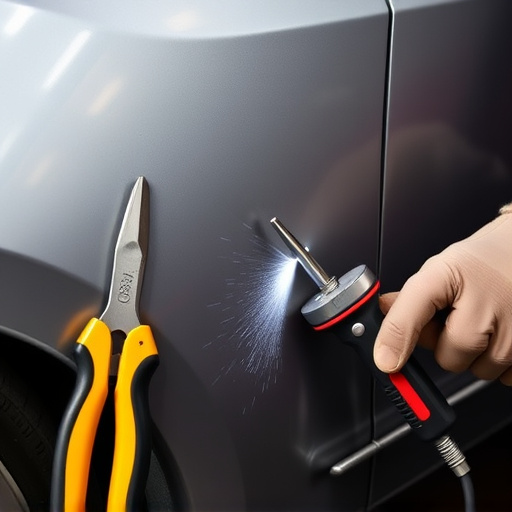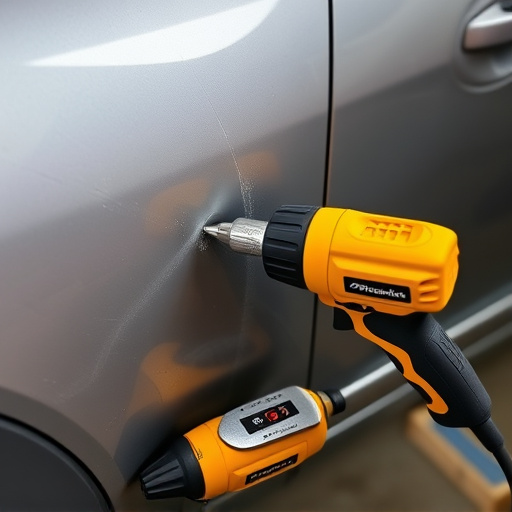The Mercedes Tire Pressure Monitor (TPMS) is a real-time tracking system for tire pressure, vital for vehicle stability and safety, especially in cold weather. It alerts drivers of any deviations from recommended PSI through warning signals or a Mercedes tire pressure monitor reset. Regular resets and checks are necessary to maintain accurate readings, optimize fuel efficiency, prevent underinflation, reduce the need for auto collision repair or car dent repair, and extend tire lifespan.
Cold weather can significantly impact your Mercedes’ tire pressure, affecting both reading accuracy and overall safety. This article delves into how the Mercedes Tire Pressure Monitor (TPMS) system works, exploring the effects of thermal expansion, freezing temperatures, and reduced air density on tire pressure. We’ll guide you through resetting your TPMS during cold weather, ensuring optimal tire pressure year-round for enhanced safety and performance. Learn how to navigate these changes and maintain your Mercedes’ tire pressure effectively.
- Understanding Mercedes Tire Pressure Monitor (TPMS) and Its Functioning
- – How TPMS works in Mercedes vehicles
- – Components of the TPMS system
Understanding Mercedes Tire Pressure Monitor (TPMS) and Its Functioning

The Mercedes Tire Pressure Monitor (TPMS) is a sophisticated system designed to ensure optimal vehicle performance and safety by tracking tire pressure levels. This technology actively monitors each tire’s pressure, providing real-time data to the driver via an in-dashboard display. When a TPMS sensor detects a pressure discrepancy, it communicates this information to the onboard computer, which can then initiate warning signals or even trigger a Mercedes tire pressure monitor reset to restore proper inflation.
The system is particularly valuable for maintaining vehicle stability and handling, especially during cold weather conditions. As temperatures drop, air density changes, affecting the pressure inside tires. The TPMS accounts for these variations, ensuring that each tire maintains the recommended PSI (pounds per square inch) for optimal performance and fuel efficiency. Should a tire’s pressure fall below the set point, the system will alert the driver, allowing for prompt auto collision repair or car dent repair, as well as enhancing overall vehicle safety and auto body services.
– How TPMS works in Mercedes vehicles

Mercedes vehicles are equipped with a Tire Pressure Monitoring System (TPMS) that plays a crucial role in ensuring optimal safety and fuel efficiency. This advanced system constantly monitors tire pressure and alerts drivers if any significant deviation occurs from the recommended PSI levels, which are typically displayed on a dashboard indicator. When cold weather sets in, it’s not just the tires that experience contraction; the TPMS sensor’s functionality can also be affected. These sensors, often located within each tire, rely on consistent temperature conditions to provide accurate pressure readings.
A drop in temperature can cause the sensors to transmit false signals, resulting in incorrect pressure readings. In such scenarios, drivers might see a “low tire pressure” warning light, which could lead them to believe their tires require immediate filling. However, during colder months, this might not reflect the actual tire condition. To address these issues, many auto repair shops offer TPMS resets, ensuring that Mercedes owners receive accurate readings and can maintain proper tire pressure, even in varying weather conditions. Regular auto maintenance, including TPMS checks, is essential to keep your vehicle safe and running smoothly.
– Components of the TPMS system

The Mercedes Tire Pressure Monitoring System (TPMS) is a sophisticated technology designed to ensure optimal vehicle safety and performance. This system continuously monitors tire pressure and alerts drivers when there’s a discrepancy, helping to prevent issues like underinflation, which can affect handling, fuel efficiency, and even lead to dangerous situations. Key components of the TPMS include sensors installed in each wheel, a control unit, and an alarm mechanism. The sensors detect air pressure levels and transmit this data wirelessly to the control unit, which then compares it against pre-set thresholds. If any tire’s pressure deviates from the norm, the control unit activates the alarm, often indicated by a dashboard warning light.
Properly maintaining TPMS is crucial for both Mercedes owners and those seeking collision repair services or body shop services. Regular checks of tire pressure, especially during seasonal changes when temperatures fluctuate, are essential. In cold weather conditions, air inside tires tends to contract, leading to reduced pressure readings. Therefore, drivers should allow enough time for the system to recalibrate after temperature changes, which might require a Mercedes tire pressure monitor reset. Keeping up with these maintenance tasks ensures not only the safety of your vehicle but also prevents unnecessary wear and tear on tires, ultimately extending their lifespan and reducing the need for frequent tire services.
The Mercedes tire pressure monitor (TPMS) plays a vital role in ensuring optimal vehicle performance and safety, especially during cold weather conditions. By understanding how this system works and the factors that can affect readings, such as temperature variations, drivers can better maintain their tires. Regular checks and proper inflation are key to keeping your Mercedes running smoothly, with accurate TPMS readings facilitating efficient fuel consumption and enhanced handling. Remember, when it comes to resetting your Mercedes tire pressure monitor, consult your vehicle’s manual for specific instructions tailored to your model.













